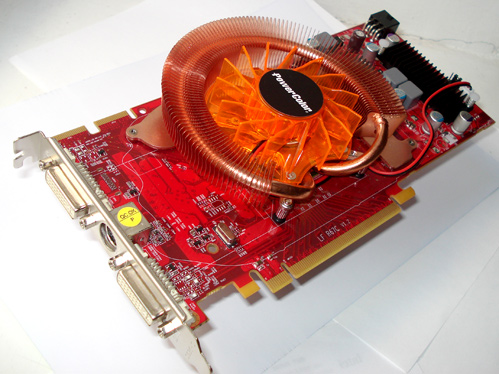

Review: PCS cooling and loads of memory
After launching their standard and overclocked lines of HD 3850 and HD 3870 graphics cards, PowerColor announced an HD3850 with 1GB of memory. We quickly managed to get our hands on their HD 3850 PCS 1GB GDDR3 and take it out for a spin. With this card, PowerColor aims at mid-range customers who still want a slightly better card and are willing to spare couple of extra bucks for something exotic. This card features an overclocked GPU running at 720MHz (compared to reference 668MHz), and the icing on the cake is the total of 1GB of memory and ZEROtherm's Professional Cooling System (PCS) cooler.


HD 3850 PCS 1GB GDDR3 uses only eight Qimonda HYB18H1G321AF-11 DDR3 chips and it’s one of the first cards that uses only 8 chips to get a total of 1GB. Previous 1GB cards had to have 16 chips in order to brag about the memory quantity.

The card’s memory kept the reference speed of 829MHz, but since Qimonda’s HYB18H1G321AF-11 memory runs at reference 900MHz we were hoping it would overclock easily. The copper heatspreader does the job of cooling the memory and the heatspreader is cooled by the fan.

The heatspreader on the memory didn’t get hot, not even during overclocking. Qimonda's 1Gb density modules are a perfect fit for the space taken up by 512Mb or 256Mb density modules so we can soon expect 2GB cards. On the other hand, who needs 2GB of memory on their card anyway ?

Using reference cooling, the chip’s temperature often reached up to 89 degrees Celsius, but PCS ZEROTherm (PCS) cooler kept it in check and we measured maximum of 56 degrees Celsius. The cooler didn’t automatically adjust speed to the temperature so the fan noise was constant and audible. We measured 39 degrees Celsius in idle mode.
In the small but quite appealing box you’ll find an HDMI adapter, driver CD, CrossFire bridge adapter and a couple of additional cables.

You can mix this or any other HD 3850 card with a stronger HD 3870 card and get Hybrid CrossFire.

Testbed:
Motherboard:
EVGA 680i SLI (Supplied by EVGA)
Processor:
Intel Core 2 Duo 6800 Extreme edition (Supplied by Intel)
Memory:
OCZ FlexXLC PC2 9200 5-5-5-18 (Supplied by OCZ)
while testing CL5-5-5-15-CR2T 1066MHz at 2.2V
PSU:
OCZ Silencer 750 Quad Black ( Supplied by OCZ)
Hard disk:
Seagate Barracuda 7200.9 80GB SATA (Supplied by Seagate)
CPU-Cooler:
Freezer 7 Pro (Supplied by Artic Cooling)
Case Fans:
Artic Cooling - Artic Fan 12 PWM
Artic Cooling - Artic Fan 8 PWM
ATI Driver:
Sample-R680_xp_vista_8-451-2-080123a
8-1_xp32_dd_ccc_wdm_enu_57717
Nvidia Driver:
169.21_forceware_winxp_32bit_english_whql
Overclocking
We couldn’t resist the temptation to overclock this card’s core and memory. We managed to clock the GPU up to 830MHz, which is almost 24% more than reference 670MHz on the HD 3850. We were pleased with the results and the card ran all the 3DMark tests flawlessly. At the same time we clocked the memory from reference 829MHz all the way up to 1GHz. We were impressed with the card’s stability at these speeds and all the Futuremarks went without a hitch.
However, problems arose when we moved on to gaming. Perfect stability during 3DMarks went down the drain, and we had to downclock to 796MHz core and 909MHz memory to achieve stability.
Futuremarks
The Overclocked PowerColor HD 3850 1GB PCS results are the ones from 830MHz core and 1GHz memory speeds. These speeds weren’t possible during gaming tests.



In 3DMarks, PowerColor beat the reference 256MB card by up to 8% (5.3% in 3DMark06), and was up to 4% better than reference HD 3850 with 512MB (3.1% in 3DMark06). Overclocking improved the result so, in 3DMark06, we see PowerColor’s card beating the reference 256MB one by 17.1% and 512MB by 14.7%. The result was almost identical to the one that 8800GT scores, and better than reference HD 3870.
For gaming tests we had to downclock the core to 796MHz and the memory to 909MHz. We couldn’t identify the problem and we might have done better if we tried harder somewhere between our initial 3DMark overclocking and downclocking to 796MHz for gaming purposes.

If you thought about HD 3850 with 256MB then think again – HD 3850 with 512MB might be a better deal. Also, you get more by switching from 256MB to 512MB than when switching from 512 to 1024MB. Still, if you overclock your PowerColor HD 3850 1GB you’ll get more than 33% improvement at higher resolutions compared to the 256MB card.


In the games we tested, we saw no significant benefit from additional memory.
Conclusion
PowerColor HD 3850 1GB PCS is the first HD 3850 with 1GB of memory that we've tested so far, and currently the only company that offers a similar card is Sapphire. Except for rare games, such as Microsoft Simulator X, you’ll hardly ever find a game that’ll find a way to utilize this amount of memory.
For those who might need graphics memory for professional use, HD 3850 1GB PCS has it to spare. We hope that developer teams will soon make owners of 1GB graphics cards happy with new titles that’ll put the huge memory capacity to good use.
The HD 3850 PCS is a multimedia card, as HDTV and HDMI are their flagship characteristics. We recommend this card to those who know exactly what they need it for, and as for the rest – the overclocked HD 3850 PCS Extreme from the same company might be the thing you’re looking for.
